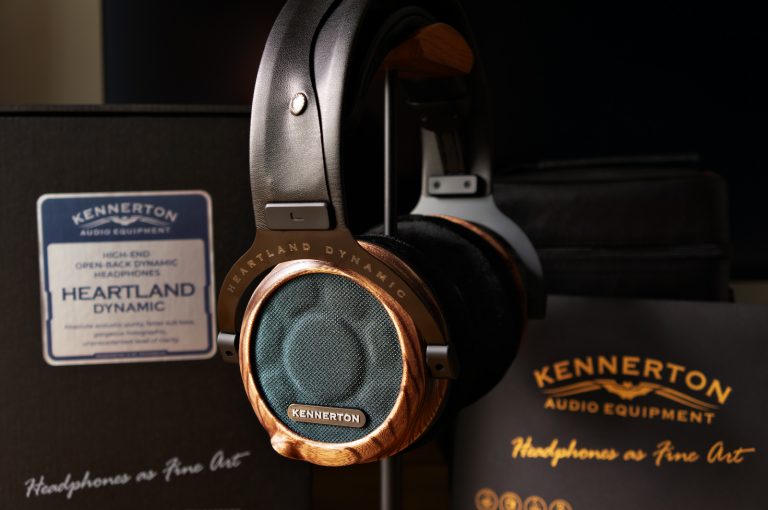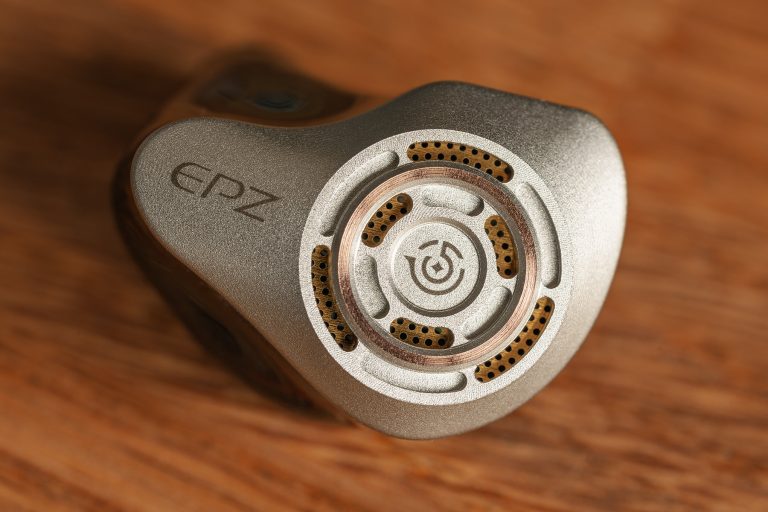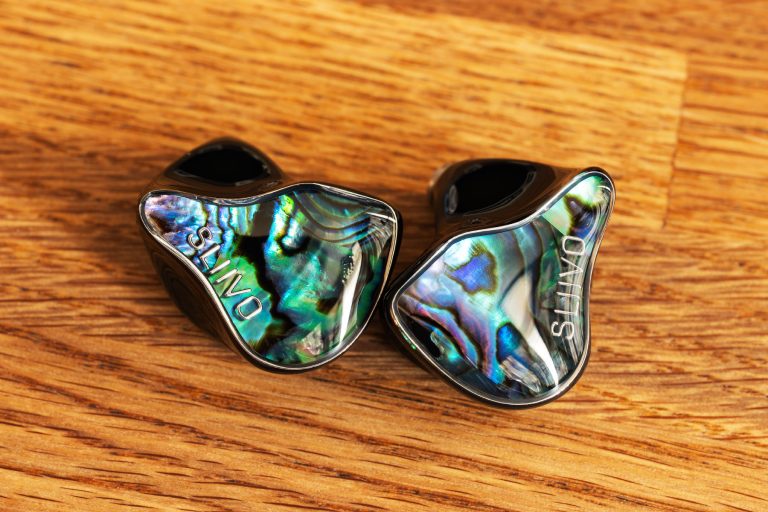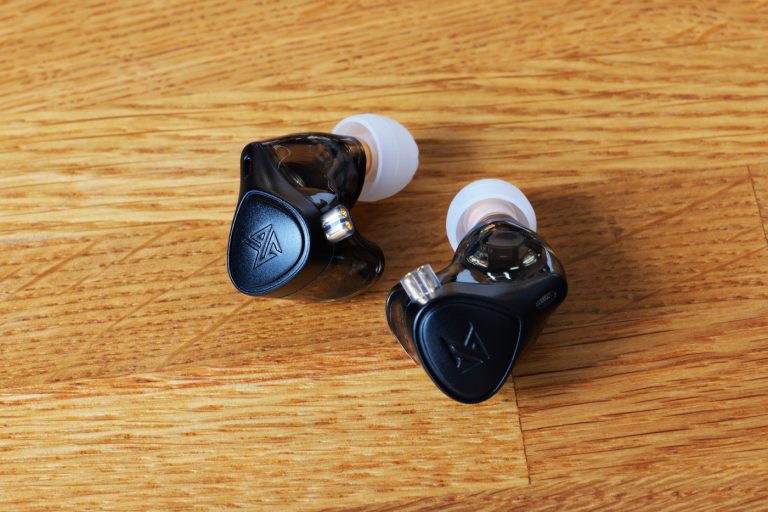KBEAR Cepheus Earphones Review
The KeepHiFi store decided to send me KBEAR earphones for a review. KBEAR’s products are… different, so to say. One day they do good things such as KB01, the next day the things are bad, such as KB02. All KBEAR models are quite budget-friendly, but here we’re talking about relatively expensive earphones, or an obvious bid for the middle price segment. And for KBEAR itself, it’s a whole flagship model.
That’s why I got interested in it and agreed.

So, today we’ll talk about KBEAR Cepheus, or KB16. Due to the current political and economic situation and the fact that I’m writing for people from different countries, I’ll have to quote different prices for different regions:
- As of May 12, 2025, the KeepHiFi store was selling Cepheus for $248 (20,500 ₽) – here’s the link to buy from them. The link is not affiliated, as I was asked to mention.
- As for Russian marketplaces, KB16 are sold for 11,700 ₽ ($141), that is, for quite different money.
The Russian audience can’t buy anything from KeepHiFi anyway, while the Western audience can’t buy anything from Russian marketplaces, so I don’t see a problem with providing this information. However, “O tempora, o mores!”, to coin a phrase. The prices matter because they set a context for comparing earphones.
All but the sound
Cepheus come in a small, neat box.
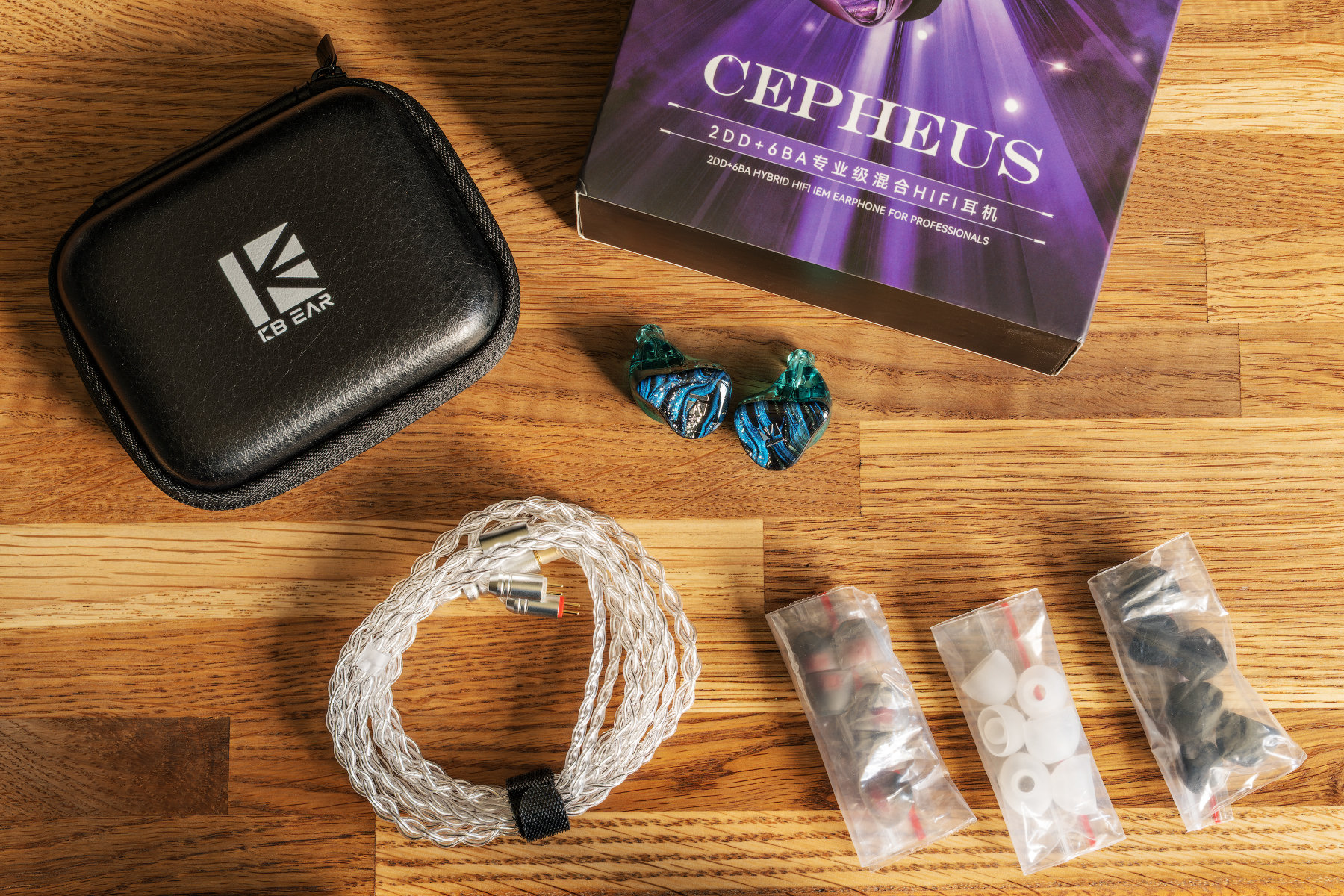
Here’s what’s inside:
- the earphones themselves;
- a cable;
- 3 sets of eartips;
- a case.
The earphones are housed in a separate compartment with two sockets:
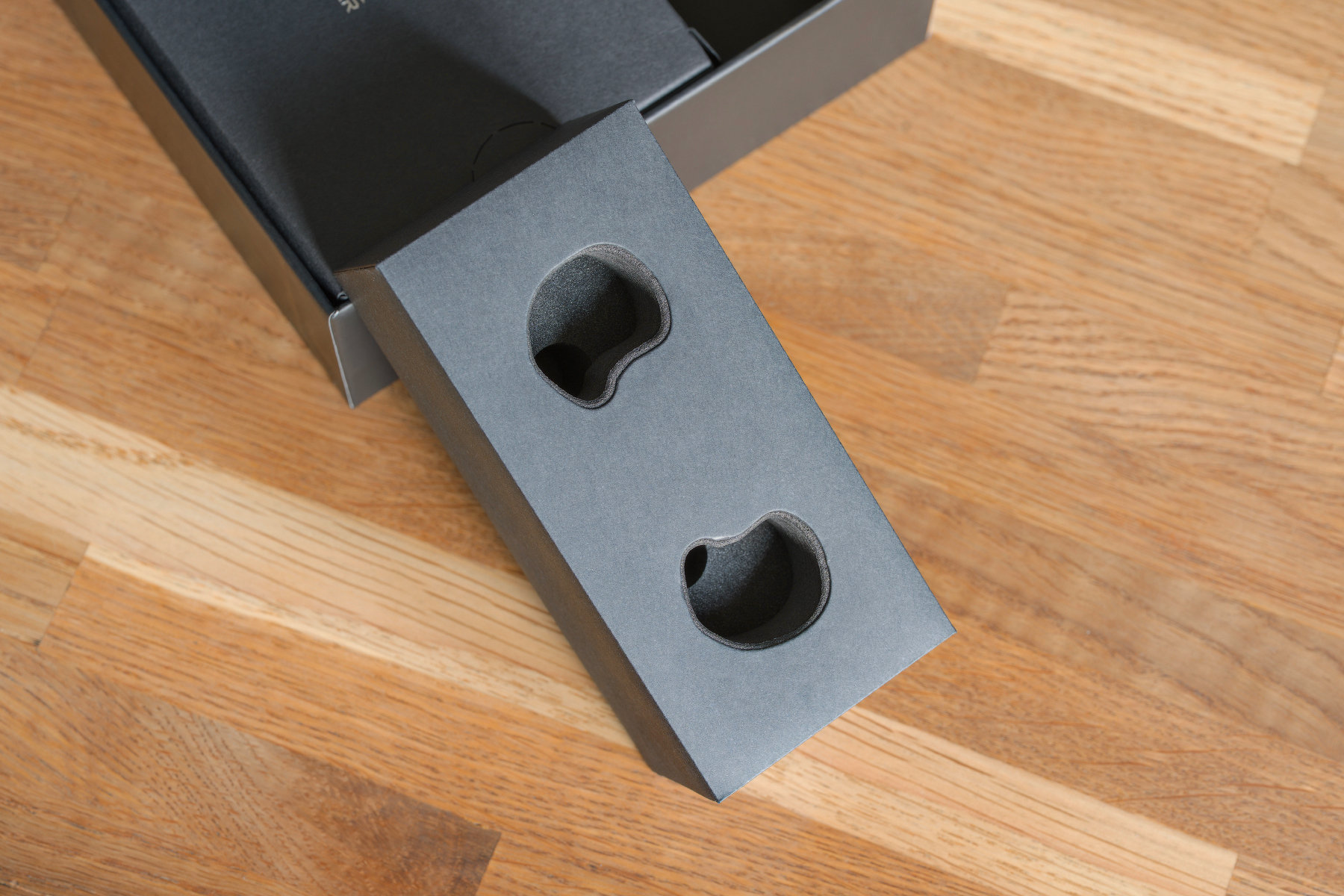
There are no holes in the back of this compartment, meaning you can’t push the earphones out with your finger or pick them up from the front. And they sit on their seats very tightly. In short, I had to shake them out like hell over my sofa for some 2 minutes. KBEAR, would you mind making some holes below?
The cable with a 3.5mm connector just looks cheap. There are no replaceable connectors, but it works as expected.
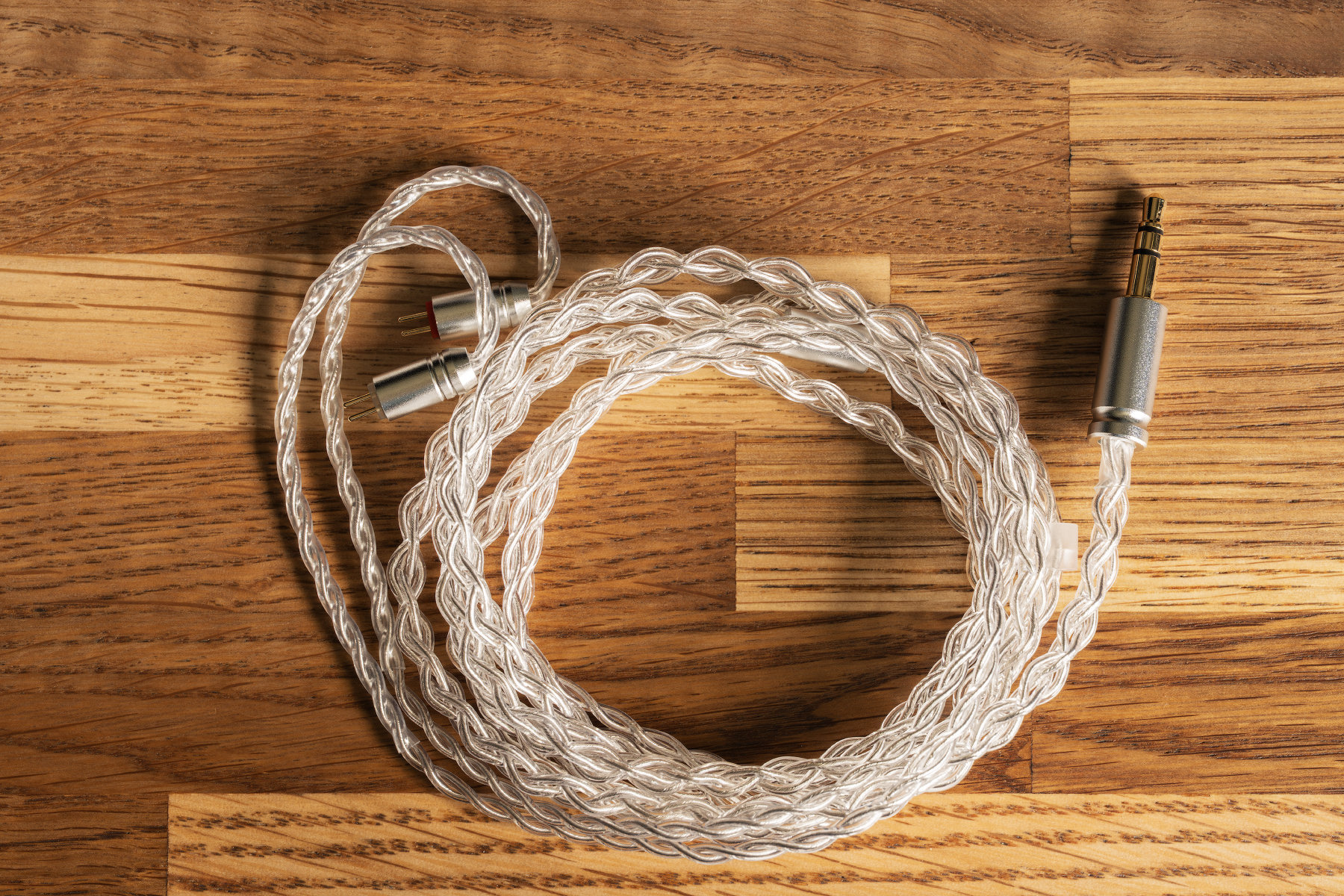
The eartips are all about the same shape, just boring silicone eartips. The black ones are made laughably poorly. There’s no difference in both sensations and measurements between them.
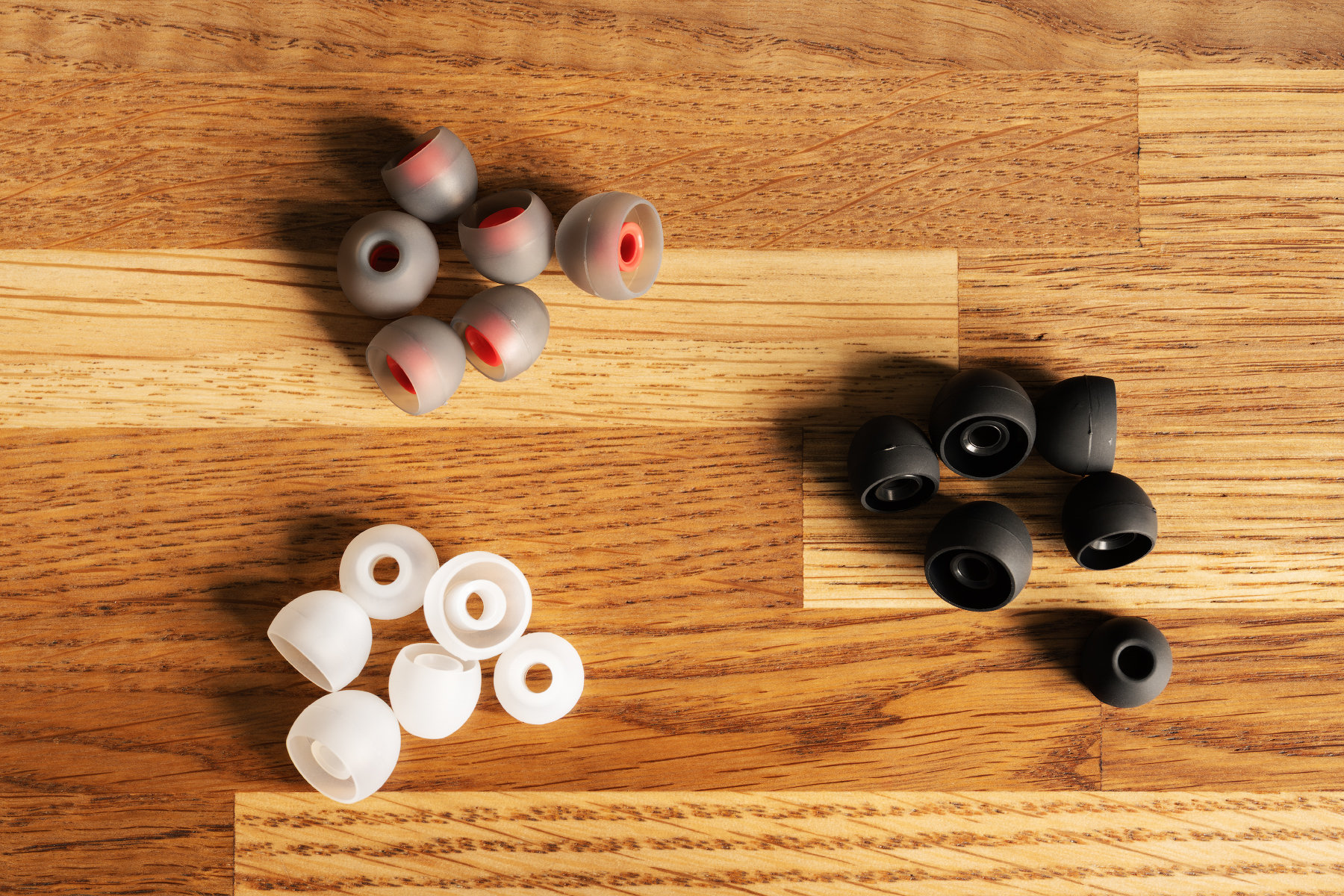
The case is bog-standard, too. We all clearly understand what it should be like.
And here are the earphones, executed in transparent hollow enclosures. You can see all the drivers inside, 2 dynamic and 6 armature ones in each earpiece.
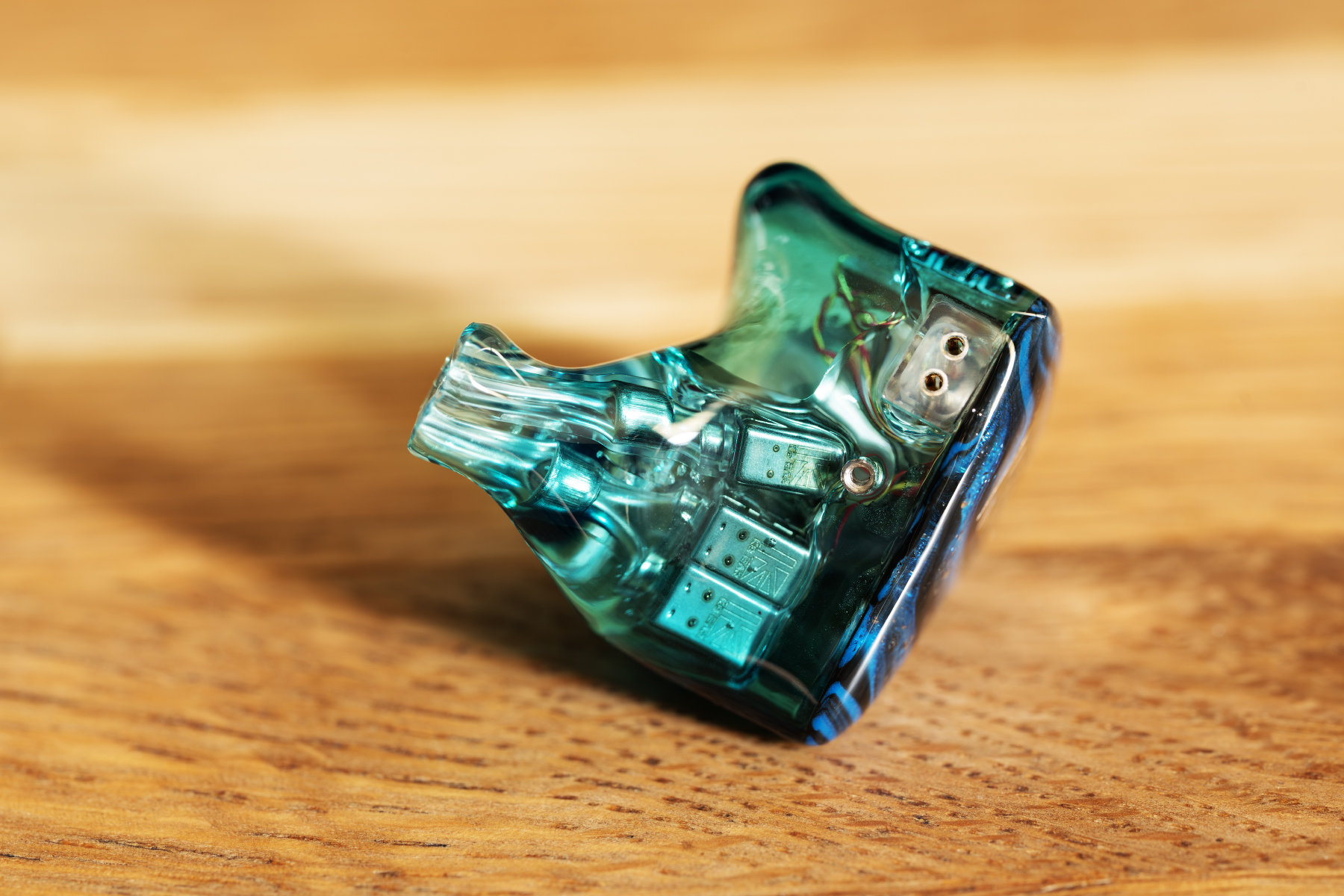

The outer inserts are opaque, sprinkled with glitter and lacquered. As far as I understand, the name of the Cepheus model is being played here, that is, the backplates are all about stars and space.
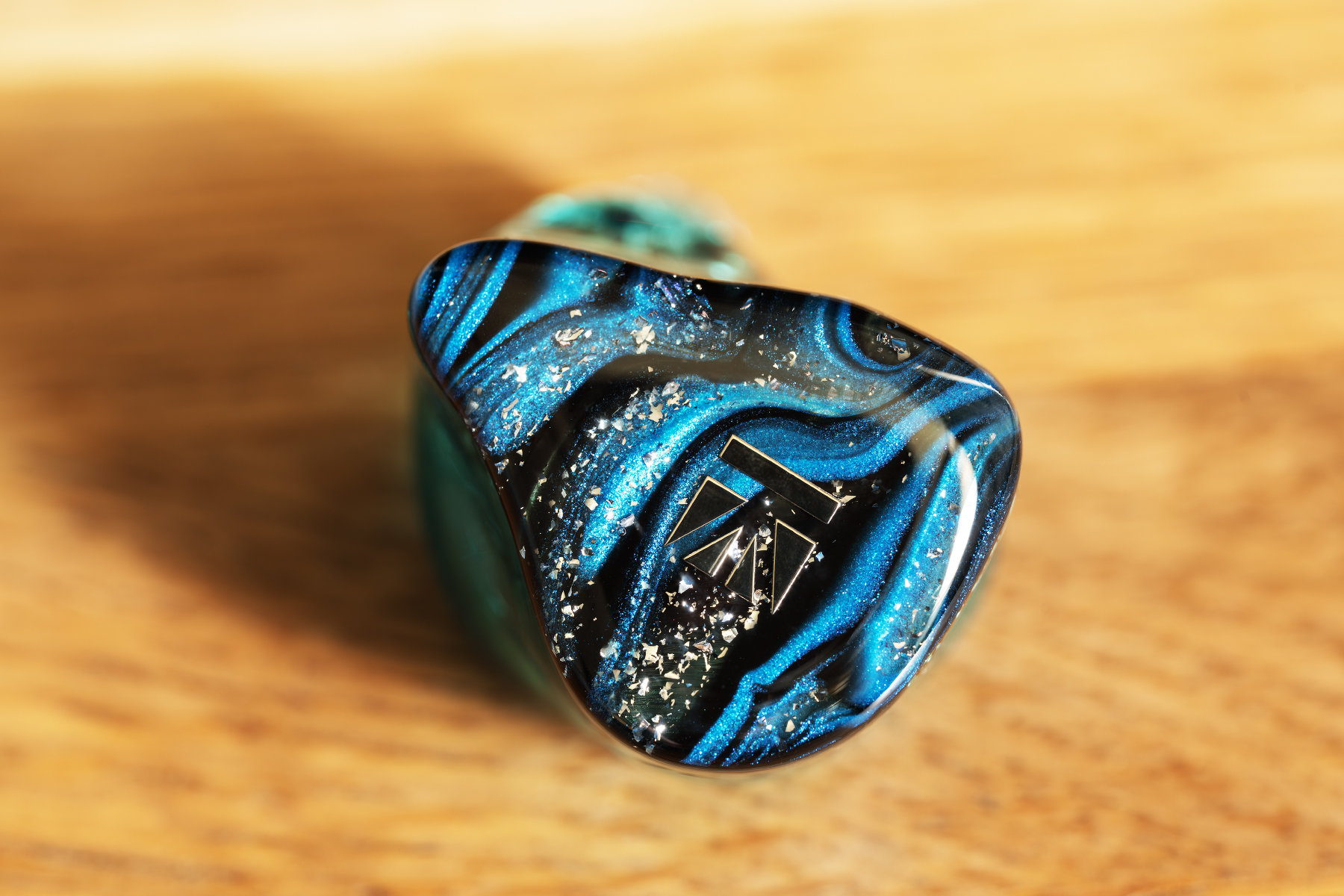
It looks cool: when you turn them in your hands, the earphones opalesce, sparkle and shine through at the same time. On the other hand, the enclosures are hollow, glue is visible inside, and you kind of want a little more weight so that the brain agrees with the Cepheus’ price. You can look at Kiwi Ears Orchestra Lite – that’s what you expect for this money in terms of the enclosures’ workmanship.
In general, I have no complaints about the level of their manufacture, but Cepheus feel frankly cheap for $250, both the earphones themselves and their accessories. If it was $140, that’d be another matter, everything would be more than acceptable.
Cepheus have been totally fine with me ergonomically: the enclosures have a correct anatomical shape and are designed for a medium-deep fit. There are no flanges on the sound ducts, but the latter are widened and turn out to be quite sufficient to hold the eartips in place in real use. The sound ducts are a bit thick, 6.5 mm, but this diameter is only at their very tips, while the average one is 6 mm. As with all other similar models, I can recommend something like Zhulinniao Zhu Rythme as decent eartips.
With sensitivity of 102 dB and impedance of 14 Ohms, any sound source will do.
The sound
You can read about my measuring rig here. Listening was performed through RME ADI-2 DAC fs and SZKOSTON CB1200AU.
The frequency response of KBEAR Cepheus:

It seems that we’re looking at an experiment in terms of the frequency balance tuning:
- the bass is slightly added, while the lower middle is dipped even more than in the Harman curve;
- the middle of the middle is noticeably emphasized, +2.5 at 1,250 Hz at maximum;
- the peak of the first resonance is shifted to 2.7 kHz from the standard 3 kHz;
- the part of the frequency response graph to the right of 8 kHz is very smooth, corresponding to the Harman standard in shape.
Nonlinear distortion at 94 dB with the ‘Use harmonic frequency as ref’ option turned off and on:
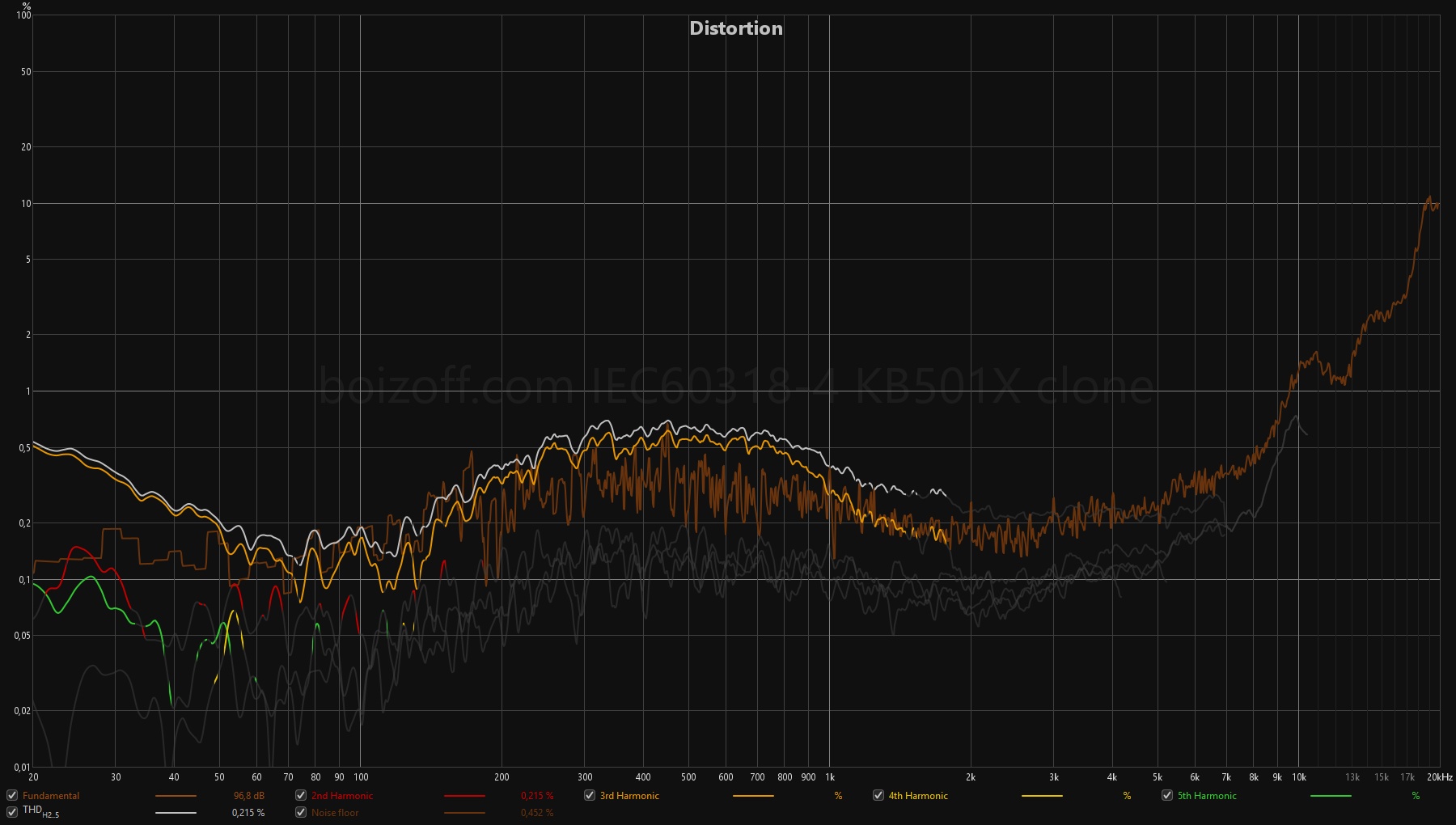
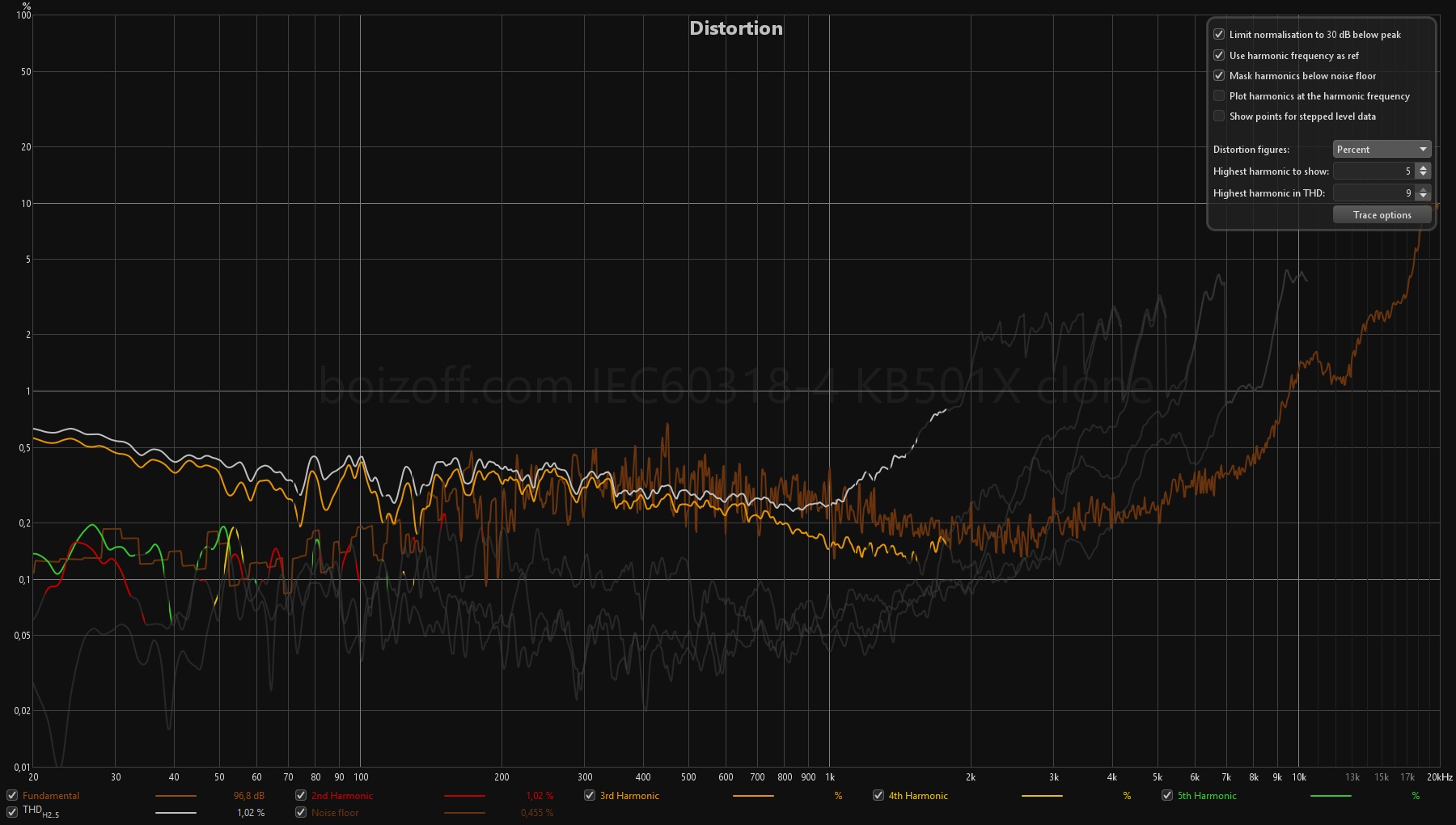
Same at 104 dB:
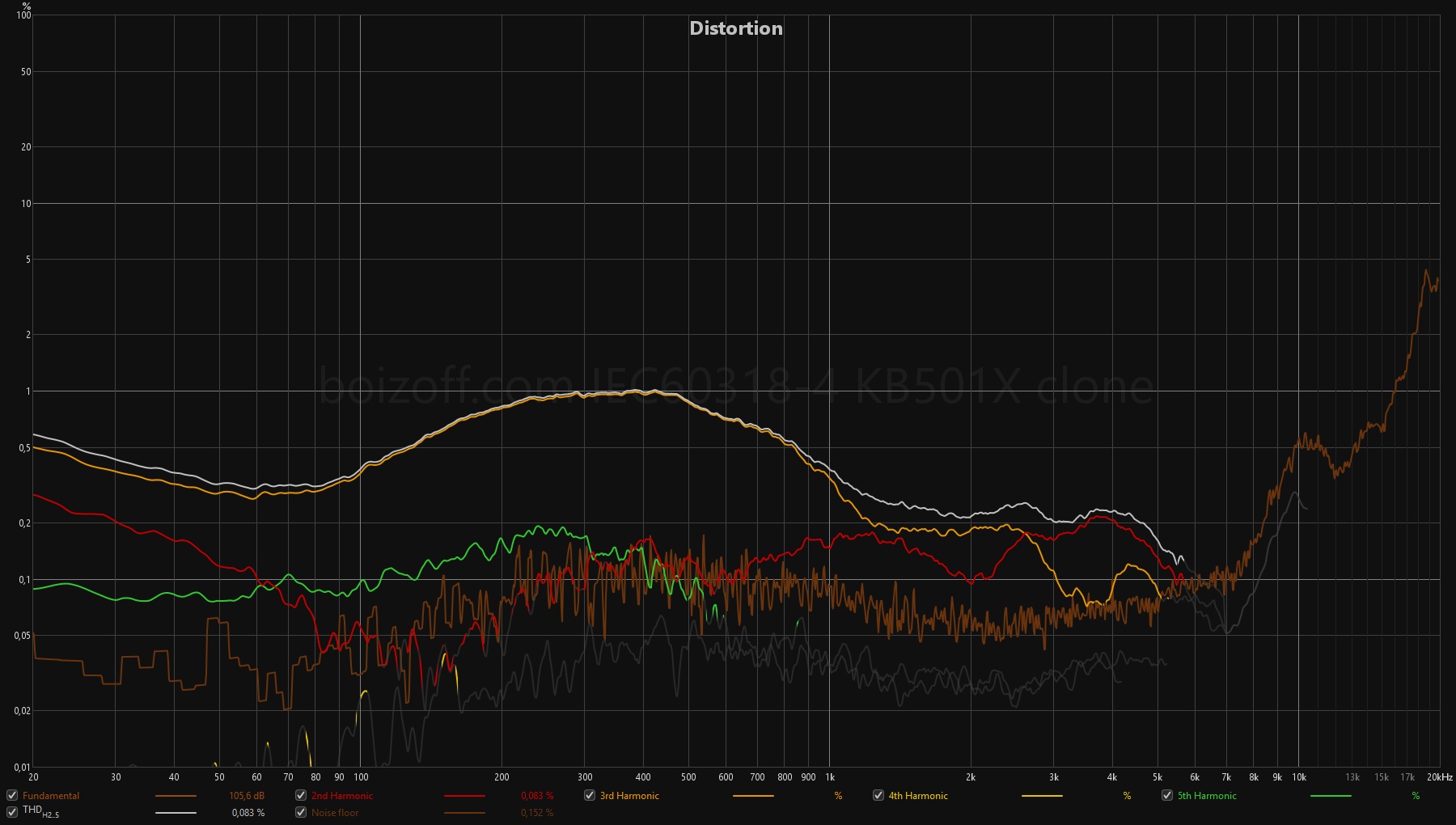
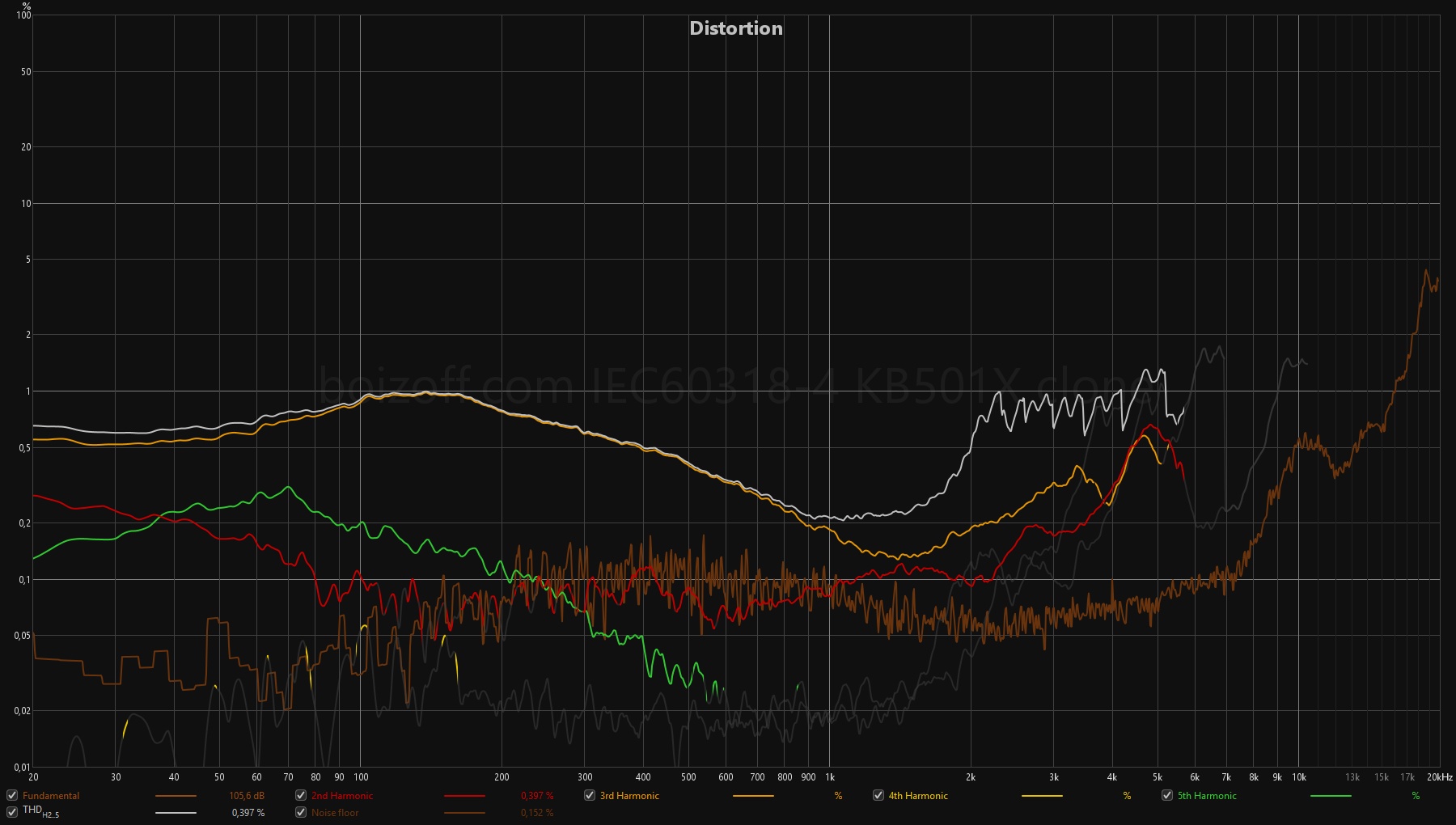
Group delay:
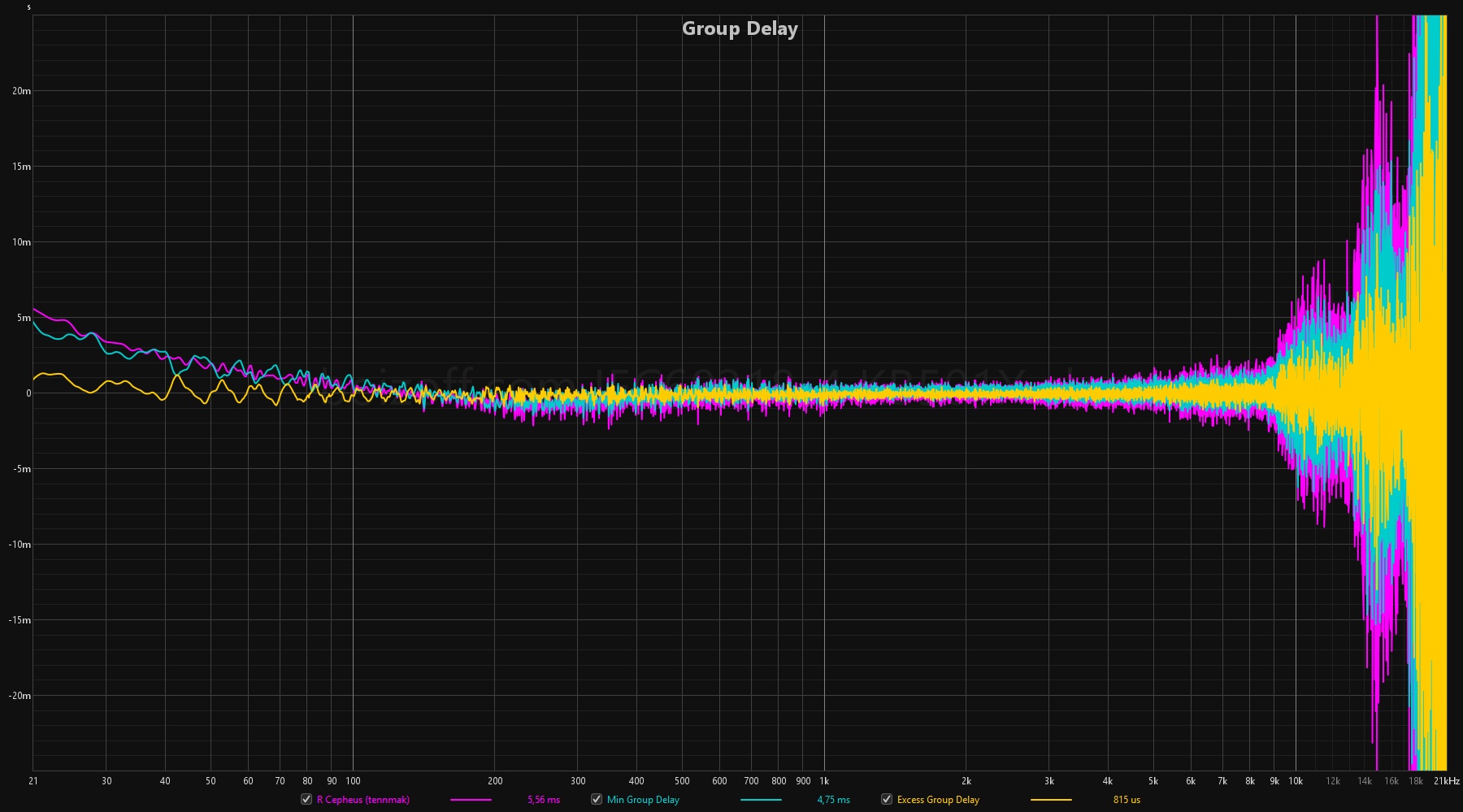
Spectrogram in the ‘Burst decay’ mode:
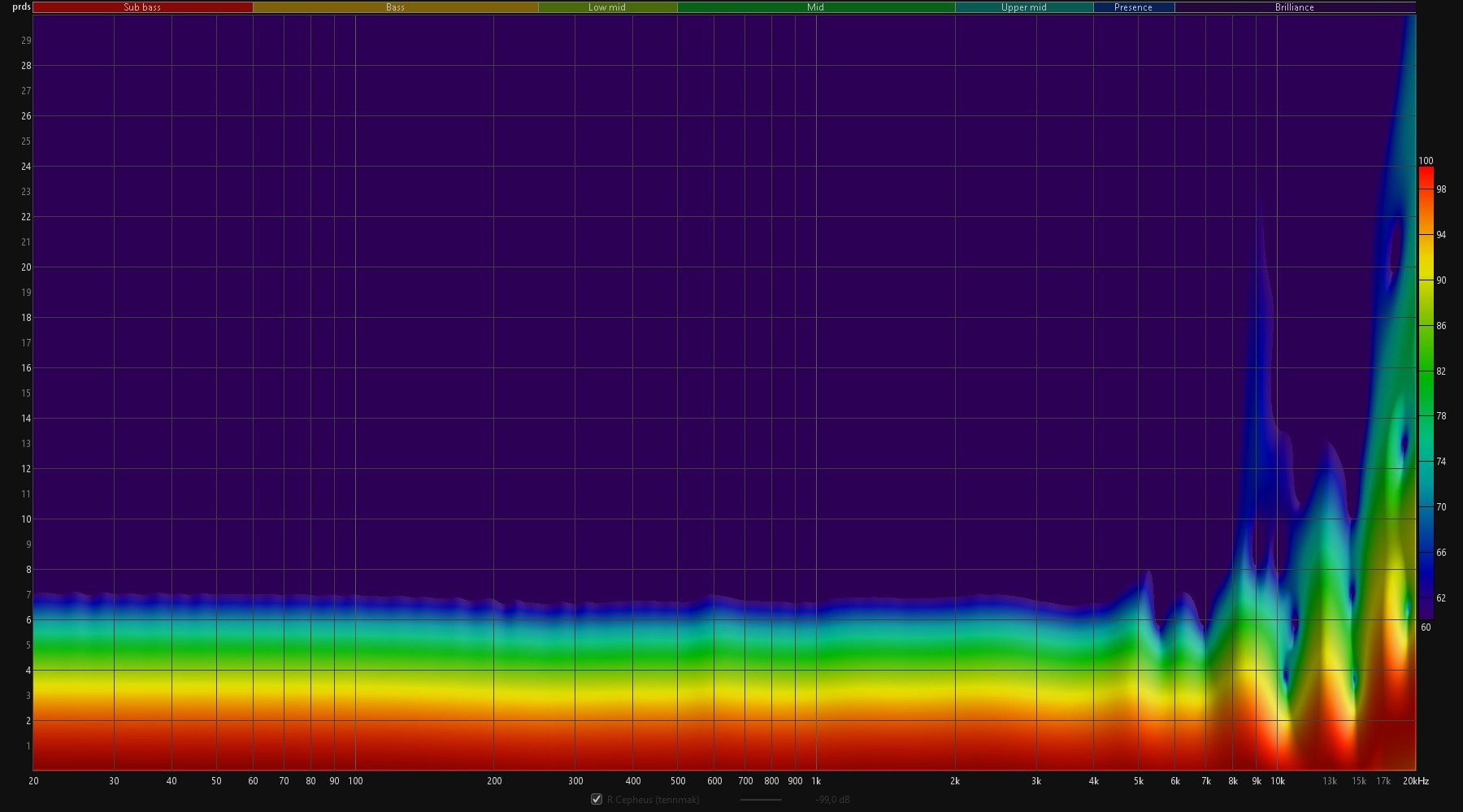
Technically, there are no complaints at all.
The main question is, how do Cepheus actually sound? The point is that such experiments with the frequency response, broadly speaking, seldom lead to good results.
I’ve been trying to find the words for a long time, but the upshot is idiotic.
Due to the fact that the ‘ear gain’ (the area of the first resonance) does not reach 2 dB (and is generally shifted to the left), I want to make the earphones louder. This makes it clear to hear the whipping subbass, which was separated from everything else by an increased ‘dip’ at 300 Hz. And, accordingly, when the volume increases, the high-frequency component is also articulated better, but there’s no feeling that any particular area is coming out due to its smoothness – the earphones just start playing louder and wider. That is, we added volume, but got sound delivery with an emphasized bottom, top and middle.
The bottom, middle and top are all emphasized at the same time. Idiotic, isn’t it?
So, I have no idea how to describe this sound properly. At one point, it even seemed to me that it was some kind of neutral sound delivery, but no way – as soon as you turn on a track with a pronounced low-frequency component, everything clicks into place: there is a lot of subbass, but it’s very good and served in strict doses. This subbass is really dry and whipping.
After several dozen hours of listening, I came to the conclusion that the Cepheus sound delivery is very dependent on the volume. “The sound delivery of any headphones…”, you may start, and I’ll immediately interrupt, “Yes, of course, the sound delivery of any headphones depends on the listening volume a lot.” It’s just that Cepheus are tuned in a way where my perception of their sound does not just change, but changes greatly, depending on the volume level. At low volume, my brain perceives their sound delivery as neutral, at medium volume – as a little V-shaped, but with a clear, ‘close’, non-Harman middle. But when at high volume, they provide a clear and slightly sonorous V-shaped sound. And this is despite the fact that due to the raised middle, you can hear a lot of details that usually escape your ears and brain because it is not customary to emphasize this range within the framework of the modern headphone tuning paradigm.
Needless to say, with the frequency response formed at medium frequencies this way, the earphones don’t just play ‘close’ — they deliver medium frequencies, including the voice, right ‘in your face’. Is it possible to make Cepheus sound ‘shrilly’ and ‘sharp’? Yes, but only at really high volume and only on some tracks. Bluntly speaking, to make them sound unpleasant, you need to turn up the volume to 96 dB, say, on the almost entirely female vocal track ‘You Were Mine’ (The Big Boss Orchestra, Tami Neilson). But this level of listening is out of bounds for me, I must admit, and the musical material is quite specific, too.
So, that’s the story!
In essence, the Cepheus sound delivery can be described as a Harman sound, but with a ‘sharpened’ middle and an even more ‘muffled’ lower middle. At the same time, the general feeling of the sound ‘wildness’ persists, but middle frequencies come almost to the fore. Dialectically, the disadvantages of such tuning are the consequences of its advantages: Cepheus sound annoyingly harshly on some tracks and at high volume, but there are frankly few tracks of this kind. However, as for the sound weight in the content where the emphasis is on the lower middle and bass, it may not be enough. It’s just a fact.
Among other things, the results of their use in games are that Cepheus are almost the only headphones that give my brain a clear, very clear difference between the sound of footsteps in front and behind in PUBG. I’ll tell you later about the second model like that (it’s notable, however, not only for locating sound sources in games).
Comparisons
If we look at Cepheus as the IEMs for 12,000 ₽ ($140), then they’ll have to compete with four models in full accordance with my rating.
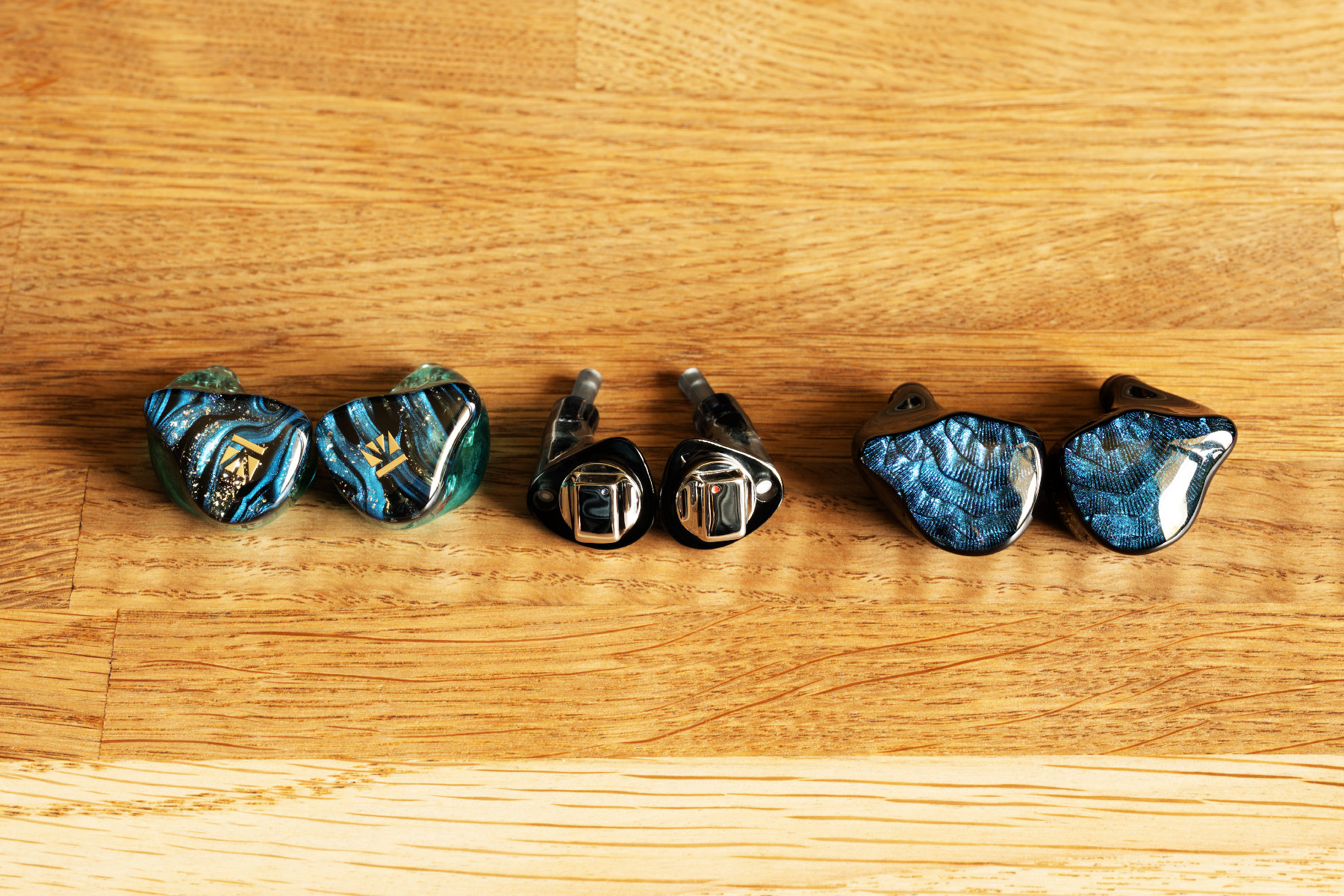
The picture is missing Kiwi Ears Quintet that I lent to test.
Cepheus vs. YU9 Audio U-556:

I wrote a comprehensive review of U-556, so now I’ll cut it simple: U-556 play in their own league and it’s almost pointless to compare anything other than Etymotic products and their clones/reinterpretations with them.
Cepheus vs. Truthear NOVA:
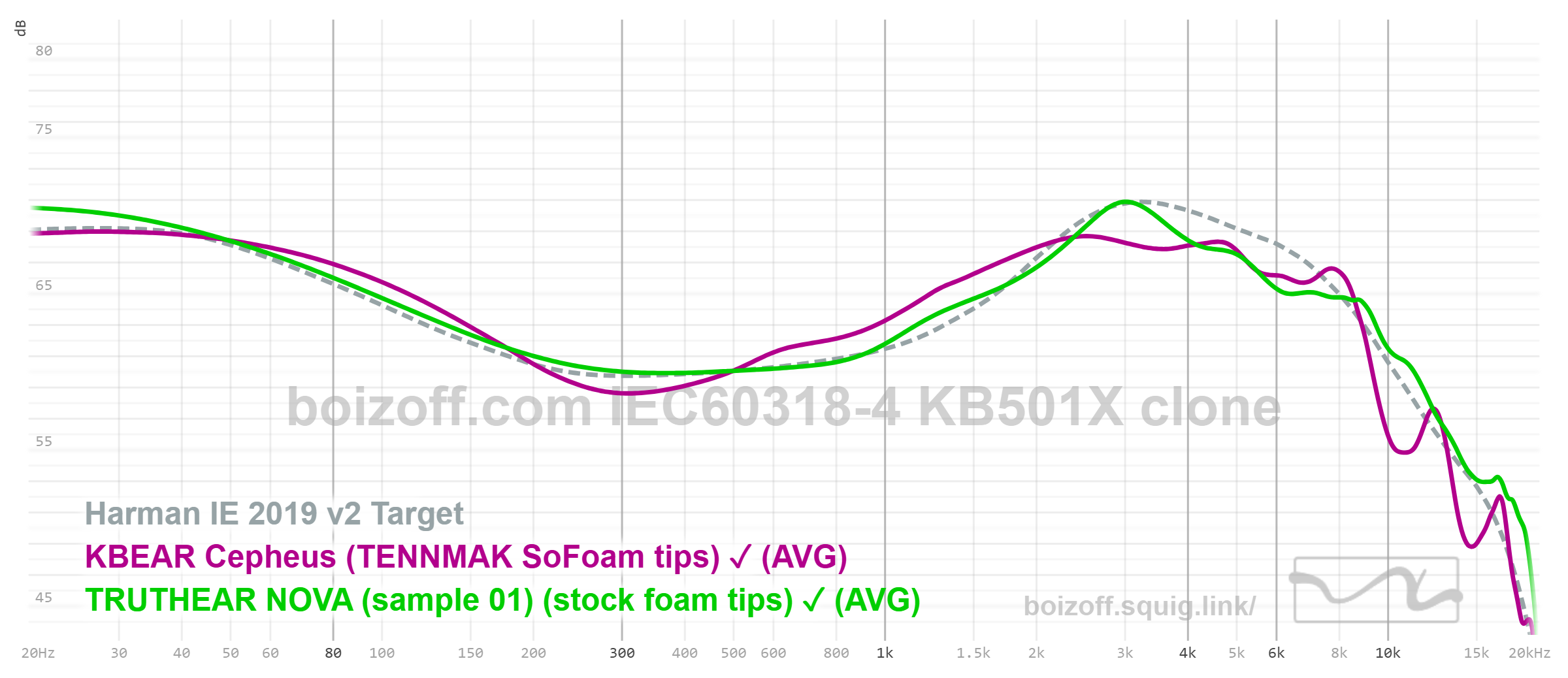
NOVA have an almost pure Harman tuning with all its pros and cons, less middle, slightly more subbass, but less bass. The key thing is that the NOVA sound remains bassy and ‘cheerful’ even playing quietly, while Cepheus will be perceived as more neutral at the same volume.
Cepheus vs. Kiwi Ears Quintet:
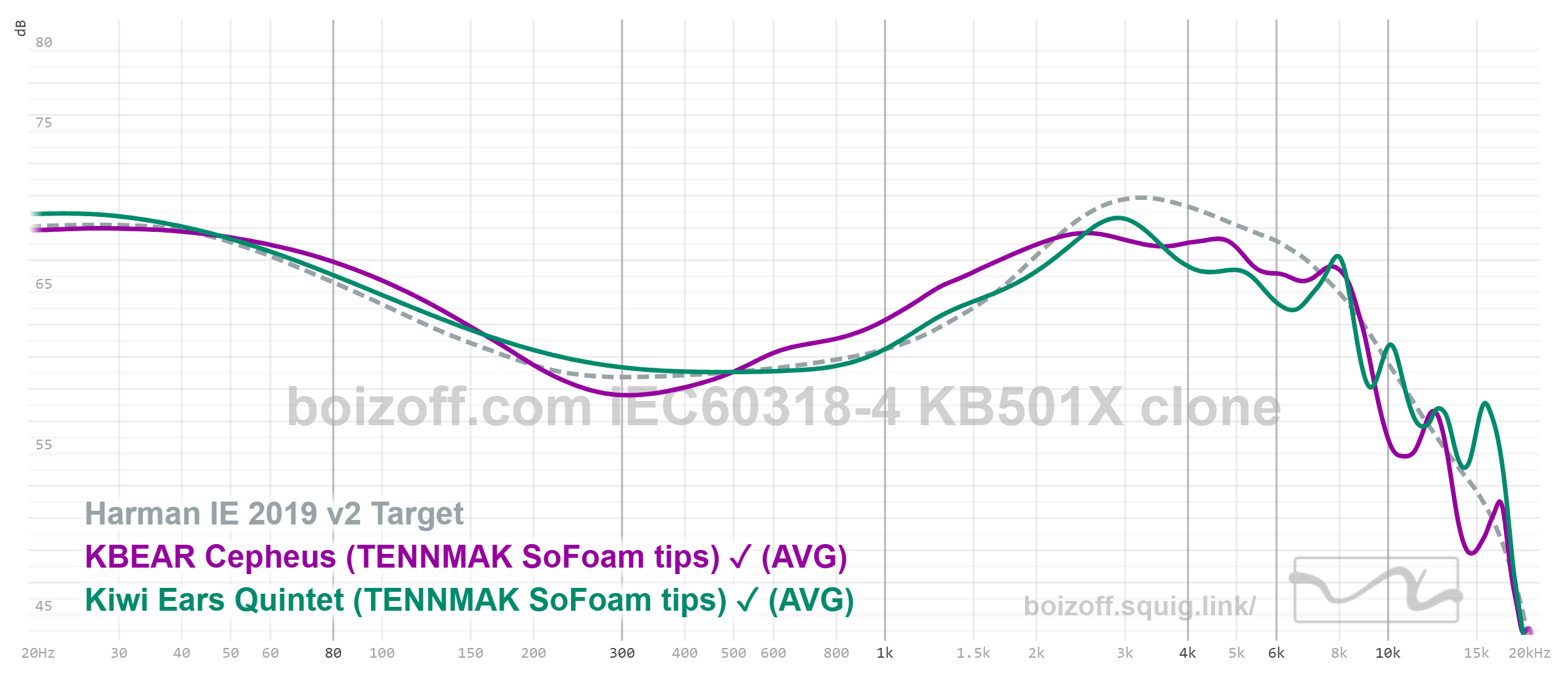
When Quintet can be safely recommended to those who find the Harman sound a little brighter than the ear requires, Cepheus are not ‘shy’ at all in the 4-8 kHz range. Compared to Quintet, KBEAR’s model is louder and more neutral.
If we look at Cepheus as the earphones for $250, then the selection of competitive models will be different:
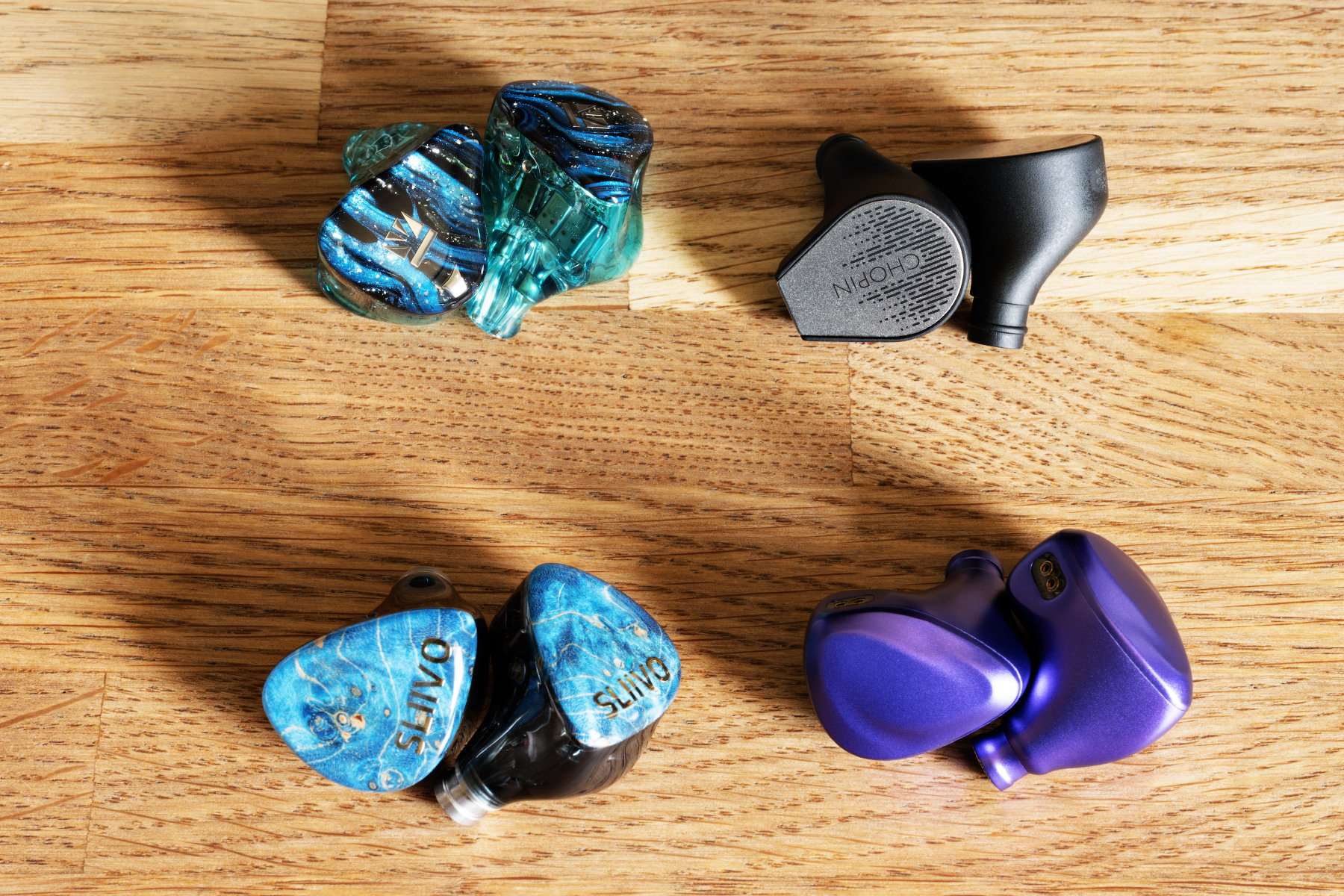
Cepheus vs. Binary Acoustic × Gizaudio Chopin:
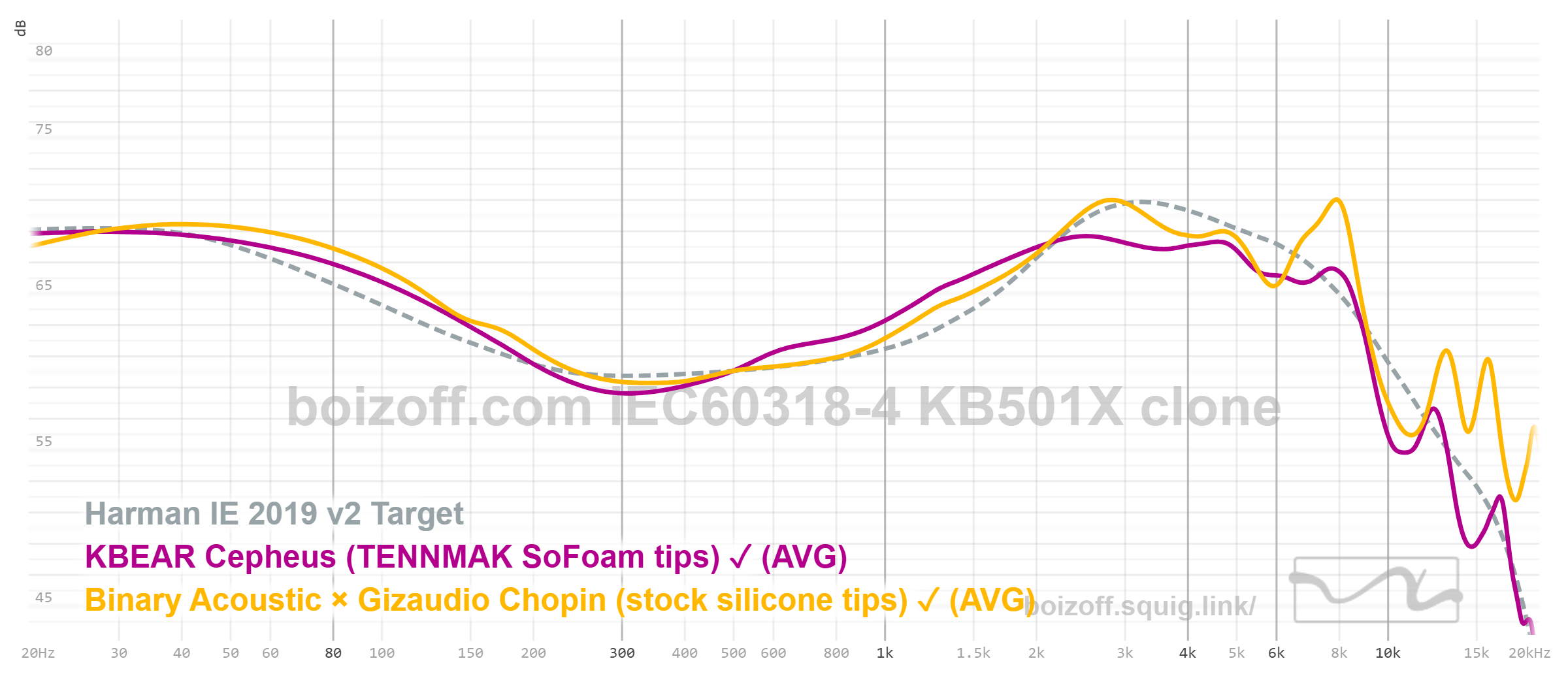
Compared to Chopin’s assertive, aggressive sound delivery, Cepheus’ one seems subtile and mid-centered. I had already written about Chopin in detail, too.
Cepheus vs. Meyr Audio SLIIVO SL41 MK2:
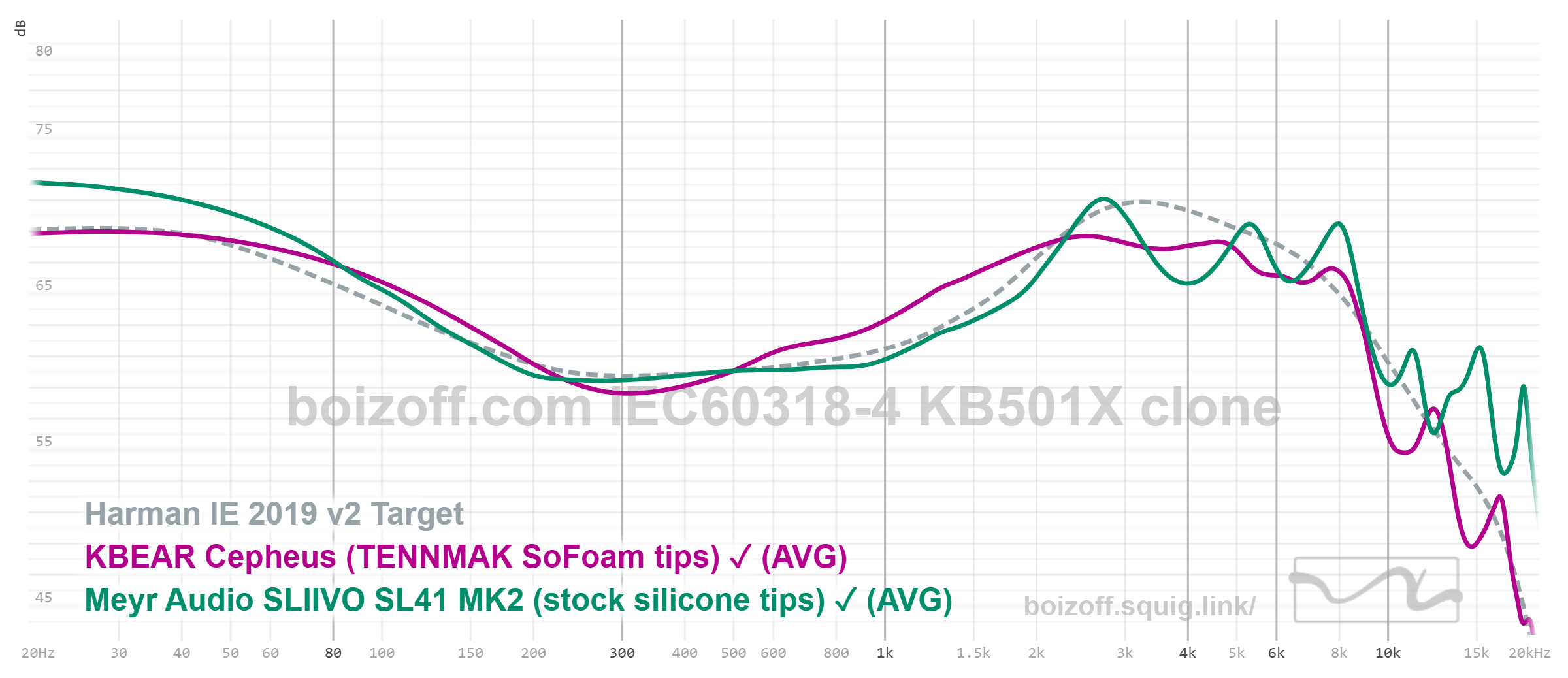
SL41 MK2 hit the user in their ears with a powerful subbass and sonorous tops. In contrast to them, Cepheus play in a prudent, balanced and dry manner.
Cepheus vs. TRI I3 MK3:
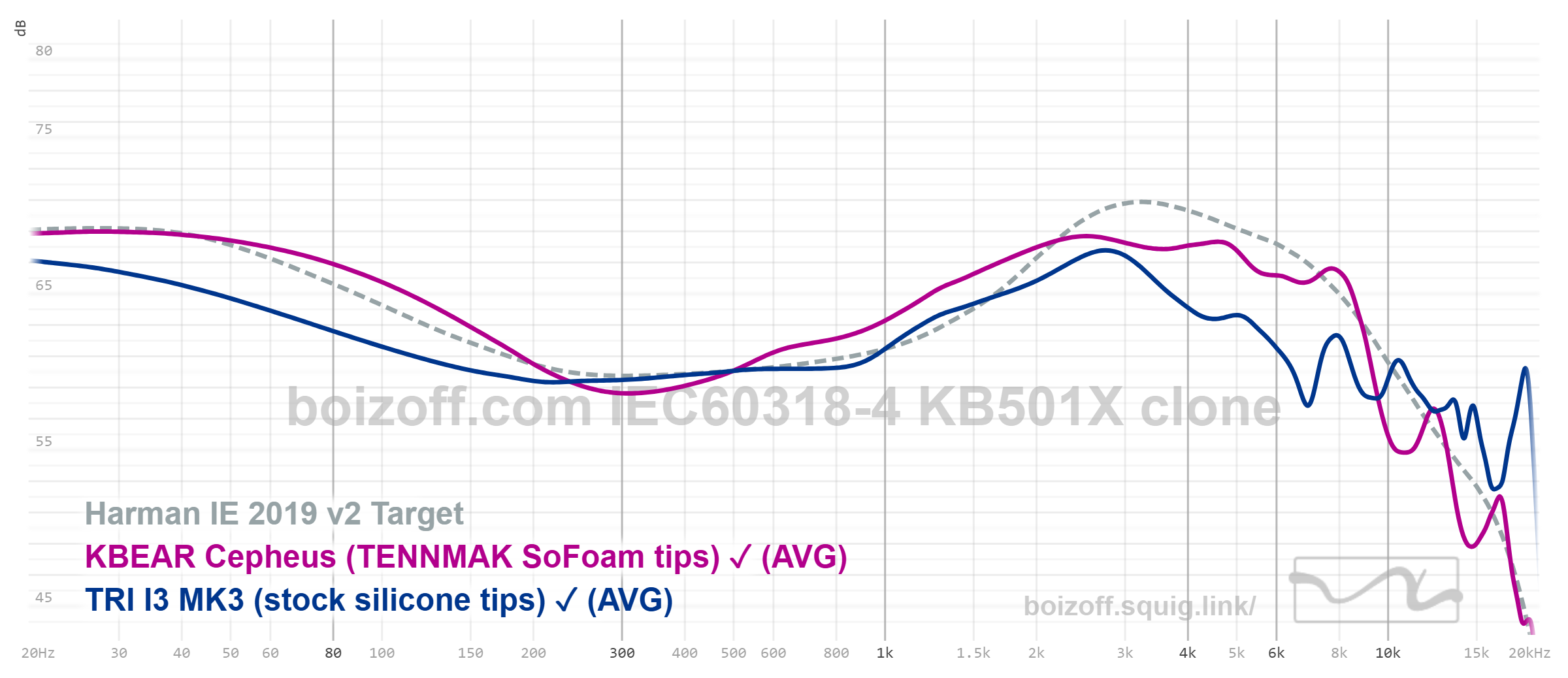
The I3 MK3 sound seems to be more neutral and ‘airy’, but at the same time one can complain about the lack of bass and the veiled delivery of a range of about 8 kHz. Cepheus provide more middle and subbass, but they don’t sound as wide and balanced.
And the most interesting comparison is with the magnificent Kiwi Ears Orchestra Lite (hereinafter referred to as OL):
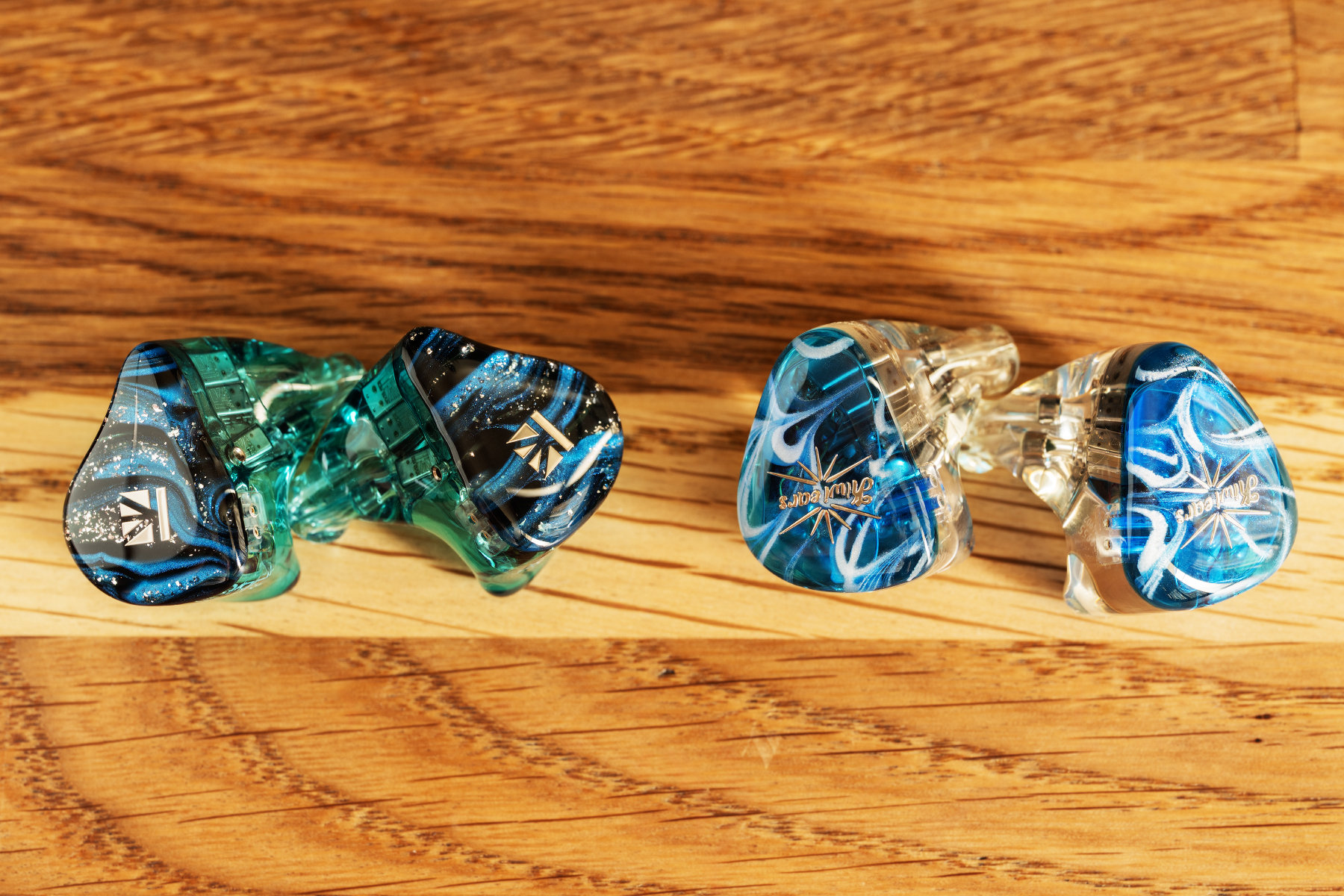
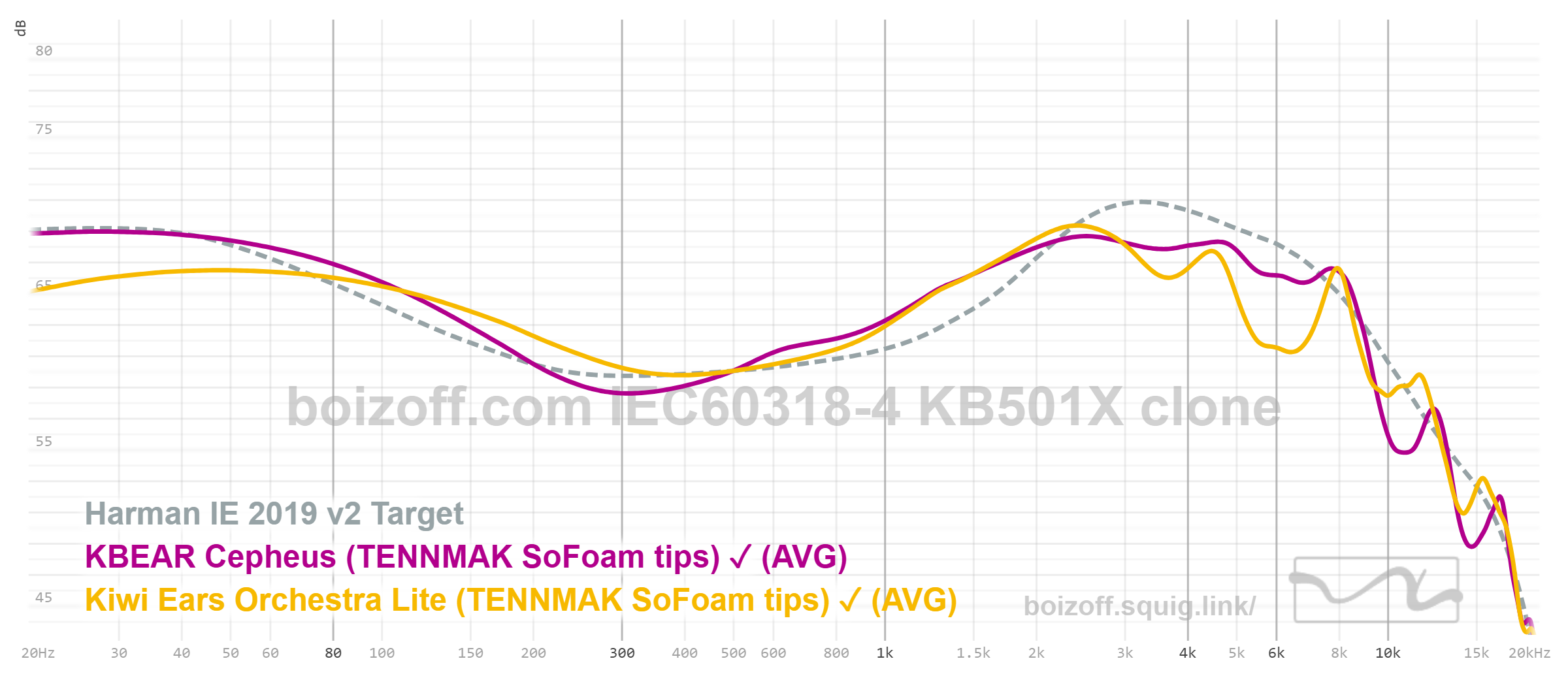
There are many similarities in these graphs: the range of 500-3,000 Hz is almost the same, and then, at the 3-10 kHz segment, Cepheus adequately and evenly play frequencies with the volume, to which OL are just trying to get closer from below, and even then occasionally. The delivery of lower middle and lower frequencies is completely different: Cepheus rely on a separated subbass, while OL, on the contrary, rely more on the bass component. As a result, Cepheus give a more lively punch and, at the same time, more ‘ringing’ at highs, whereas OL are bassier, but have less even treble. And, let me remind you, OL don’t have pressure compensation holes – you need a certain skill to place them in your ears without the effect of clogged ears.
Finally, OL are those very other earphones, in which I can clearly distinguish the steps in front of and behind me in games.
Summary
I can congratulate KBEAR with all my heart. They managed to do what any IEMs manufacturer should dream of – they did it ‘not as the next man’ and ‘well’ all at once.
In truth, such dashing experiments with the frequency response are usually about doing ‘not as the next man’ only.
Cepheus have their own unique sound delivery, which is kind of somewhere in between the Harman standard and neutrality. And it’s not about the amount of bass and high frequencies. The emphasis in their sound is on the nature of the midrange component delivery: the Cepheus sound is simultaneously ‘informative’, even ‘analytical’, but also quite capable of entertaining the user with both a sparkling smooth top and a percussive subbass, and with almost no loss of tonal reliability. I say ‘almost’ because the reduced 300 Hz are still brought to light on some tracks. Sometimes you’d expect more weight in the sound.
The outcome is cool anyway, especially taking into account that KBEAR has never (supposedly) tried to compete in the $200+ price segment before.
There is also what to scold Cepheus for: at this price, you’d expect different eartips (at least properly made, but if only they were more diverse, too), different cable quality and, most importantly, better-made enclosures. I hate to say it, but Basso Jr. KLEE for $50 have been brought to me today, and there’s already a decent cable with replaceable connectors there for that money.
To buy or not to buy: to buy if you are not afraid of pronounced midrange frequencies, which may sound annoying and/or harsh on some tracks and at high volume. From my subjective point of view, these are really great headphones, especially if they drop to $170-190. And if I were asked to recommend something for competitive games, I would mention the Cepheus model as one of the first.

